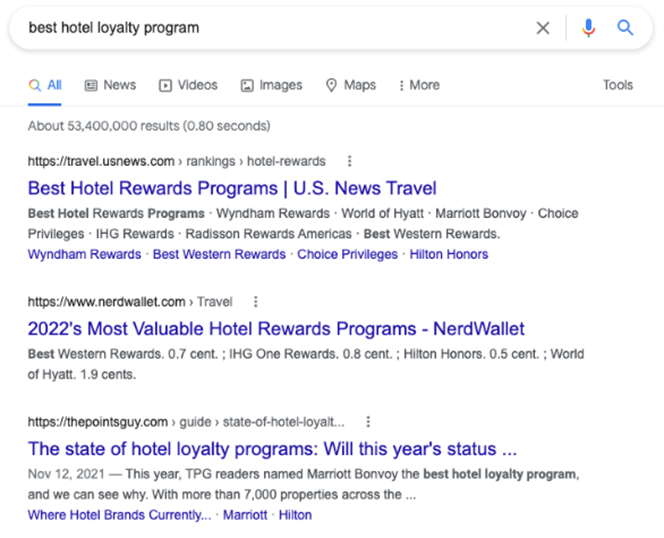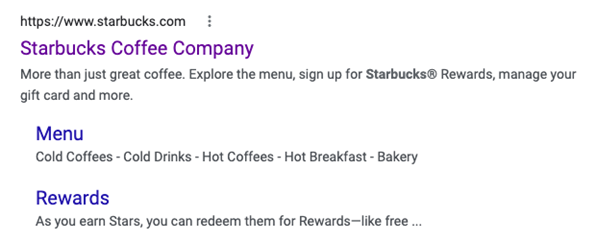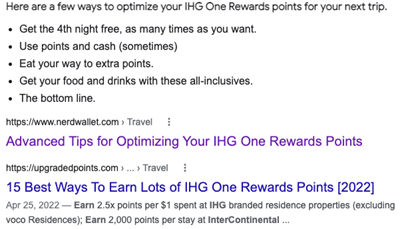How to maximize search results for your brand’s loyalty program
It’s a pretty safe bet that you’ve used a search engine as part of your online activities today. Most of us search for something three to four times a day on Google, with an average of 8.5 billion searches taking place on a typical day. But it’s not just Google. High-traffic e-commerce and social media platforms—e.g., Amazon and YouTube—rely on visitor search queries to drive their experiences.
Most major brands spend aggressively to secure top search results to acquire new customers for their products or services. When it comes to promoting the benefits of their loyalty programs, however, search results are often buried past page two—or they’re missing entirely. And, let’s face it, few people look at search results past page one. Instead of finding brand websites promoting their loyalty programs, the top returns for “best [insert industry] loyalty program” searches are third-party rankings and review websites, such as ThePointsGuy.com, NerdWallet.com, Wallethub.com, and others.
For example, a search for “best hotel loyalty program” generates nonbranded results with a variety of reviews or rankings lists. These websites can be valuable resources for high-level consumer comparisons, but there is a missed opportunity and a certain amount of risk for brands when these types of commentary rank in the first-page returns. As a brand manager, you don’t want to be at the mercy of third-party websites to deliver the messaging and value proposition of your loyalty program. Even riskier, several of these rankings are based on purchased placement. In those cases, the content is biased from the start and doesn’t reflect the true delivery of value

Brands with established loyalty programs often find their loyal customers account for nearly 70% of their sales. Considering the value of customer loyalty, prioritizing your program benefits as a core offering in search results can help you take control of the narrative and drive incremental program enrollment and engagement.
Start by establishing a proactive search engine optimization (SEO) strategy that elevates your brand offering, creates differentiation, and improves your return on investment. Here are five tips to help you improve your brand’s search relevance.
1. Start the consumer journey with loyalty appeal
According to a BrightEdge report, 68% of consumer decision-making and purchasing journeys start with a search engine query. While most commodity brands default to competing on discounts and price in search results, brands with loyalty programs have a measurable opportunity to deliver a higher perceived value at first impression. By including program perks for members, as shown in National Rental Car’s home page listing, the opportunity evolves from a one-time discount on a single transaction to a long-lasting value exchange delivered throughout the customer relationship.
In National Car Rental’s case, a consumer booking a car through National from this search listing result has an immediate incentive to join the loyalty program to enjoy the promoted perks:

Similarly, Starbucks features its loyalty program prominently in the brand’s search listing information to promote the value of membership at the entry point of their website.

2. Incentivize by including member-exclusive deals
If your industry demands price discounts to compete for high-frequency purchases—e.g., quick-serve restaurants—it’s still possible to include the loyalty program benefits alongside discounts. By featuring member-exclusive deals (rewards and discounts) in the loyalty program, as done by McDonald’s and Subway in the examples that follow, the value proposition of the program and the payout are front and center. Thus, the online shopper sees the benefits beyond the in-the-moment discount.


3. Inspire loyalty membership engagement and enrollment with YouTube searches
Most people don’t think of YouTube as a search engine, but it’s been the second most-searched website for well over a decade–just behind its parent company, Google. Given that keyword tactics for search-engine optimization apply to video content published on YouTube, it provides a dynamic storytelling opportunity within the typically static search results page.
Marriott excels in promoting its YouTube videos across search engines. The brand publishes meaningful loyalty membership videos and proactively optimizes them for relevant keywords in search queries. In the accompanying example, Marriott blends branded and nonbranded keywords to drive a strong presence in Google and YouTube search results.

4. Drive online orders from search with loyalty perks
No matter the category, loyalty programs’ capacity to retain and incentivize the most valuable customers is well established. Many brands offer customers some form of purchase rewards to drive return business. That strategy opens an opportunity for a brand with a robust loyalty offering to differentiate itself by offering an irresistible package of perks that meet the customer’s needs in the “searchable” moment.
In these examples, Ulta Beauty and Foot Locker include their unique loyalty member benefits in their home-page descriptions. For organic search returns, this tactic automatically highlights the benefits of program membership and may even drive new program enrollment for those seeking immediate benefits.


5. Stretch your web presence and increase rankings by sharing member earning tips
The popularity of third-party loyalty program rankings and review websites stems largely from the insider tips provided on how to maximize point accruals and reward redemptions. Major brands can leverage this approach as well by proactively publishing membership content with tips to accelerate program status and receive additional benefits. The major benefit in this approach for brands is better capturing search results while encouraging external websites to feature their program more accurately and frequently.
IHG Hotels & Resorts regularly shares earning tips publicly for existing and new members to learn how to maximize their reward accrual. These tips then get picked up by prominent affiliate websites, as shown here, which leads to earned published content for their readers.

Lean into Loyalty Value Propositions
When it comes to search-engine presence for loyalty programs, brands have a distinct opportunity to better control their outcomes. Strategic application of an SEO strategy that focuses on loyalty program value propositions can increase member engagement and drive new loyalty enrollments. Knowing that 75% of consumers favor companies that offer rewards, it’s critical for brands to reveal their loyalty benefits early in consumers’ considerations—and online search listings are a vital way to do that. Otherwise, a brand’s potential best customers are left searching for loyalty in all the wrong places.



![[Research Round-Up] New Study Shows the Continuing Value of B2B Thought Leadership](https://customerthink.com/wp-content/uploads/development-2010010_1280-pixabay-innovation-ideas-think-1-218x150.jpg)